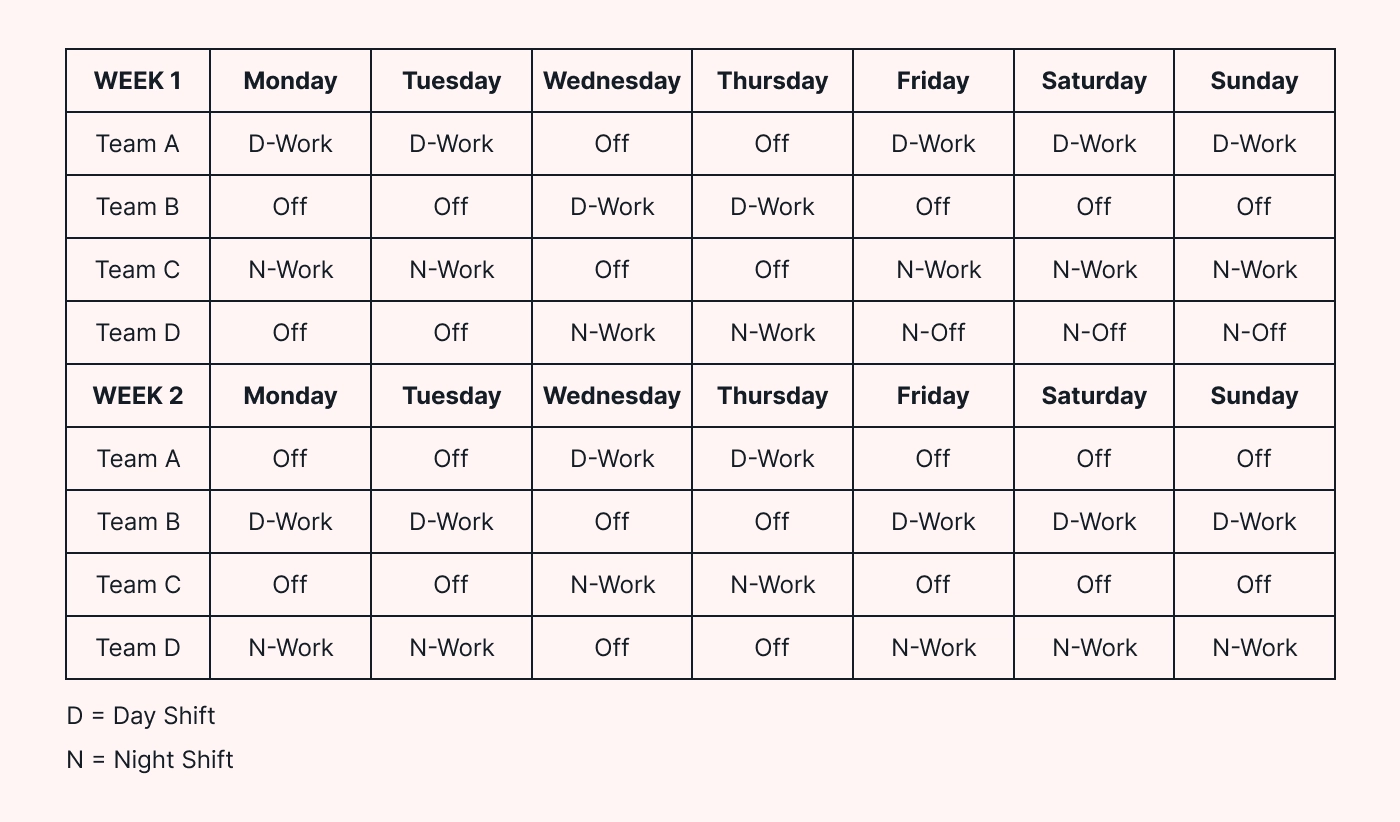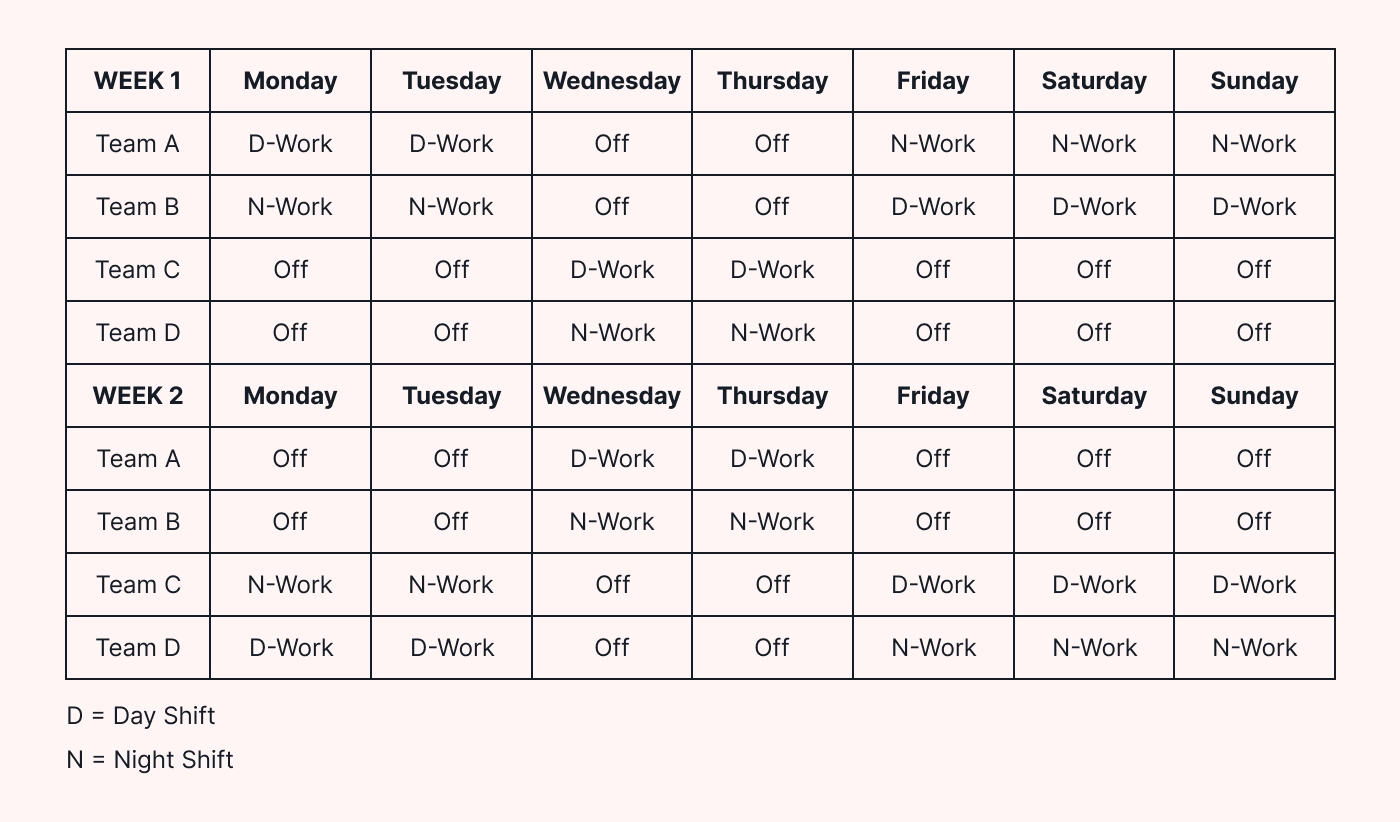Are you facing the challenge of maintaining 24/7 operations in your company or organization?
If so, the 2-2-3 schedule offers a solution that can keep production and services running smoothly around the clock.
This guide will show you how to implement this rotating shift pattern so your operations never skip a beat and your employees’ well-being is maintained.
What is the 2-2-3 schedule?
The 2-2-3 work schedule is a type of rotating shift schedule often used in industries that require 24/7 coverage, such as healthcare and manufacturing.
Employees on this schedule typically work for two days, then have two days off, followed by another three days of work. The 2-2-3 schedule also alternates regularly between day and night shifts.
Its key feature is that it consistently provides employees with a mix of workdays and days off while keeping workplace operations going around the clock.
Why is the 2-2-3 schedule also called the Panama schedule?
The 2-2-3 work schedule is sometimes referred to as the Panama schedule due to its historical association with the Panama Canal.
When the Panama Canal was under American administration, this scheduling system was developed to manage the round-the-clock operations that were required to keep the canal functioning and well-maintained. It has since been adopted in various other industries that require 24/7 operation.
Who uses the 2-2-3 schedule?
The 2-2-3 work schedule is typically used in industries that require continuous, 24/7 operations that use both day and night shifts.
Night shifts can be challenging, but they’re not uncommon. Roughly 11 million adults in the US typically work night shifts for at least one week per month.
Here’s a list of some industries that use the 2-2-3 pattern for employee scheduling to manage night shifts and continuous operations:
- Hospitals and other healthcare facilities that provide patient care around the clock

- Police, fire, and emergency medical services that operate non-stop and need to keep all shifts manned
- Factories, especially those that use continuous production processes
- Power plants, water treatment facilities, and other utility services that need to operate at all times
- Transportation hubs and services such as air traffic control, public transportation, and freight and logistics that operate 24/7
- Customer service centers that provide round-the-clock support, like call centers for international companies
All of these industries require appropriate shift scheduling to manage their operations.
How does the 2-2-3 schedule work for individual employees?
The basic premise of the 2-2-3 schedule is that it uses 12-hour shifts to provide staffing for continuous operations. Within this pattern, there are different ways to make this schedule work.
Let’s look at the basic pattern first.
The basic 2-2-3 schedule
A typical work month for someone on a 2-2-3 schedule involves a repeating pattern of working a few long days followed by a few days off.
Here’s what this looks like over a two-week period:
Week 1
Days 1 & 2: Work
Days 3 & 4: Off
Days 5, 6, & 7: Work
Week 2
Days 8 & 9: Off
Days 10 & 11: Work
Days 12, 13, & 14: Off
When plotting this pattern on a calendar, it looks like this:
 |
This 14-day rotational cycle repeats itself starting with Week 3. So, in a typical month, an employee will typically work 15 days and have 15 days off.
Because these shifts are 12 hours each, a person on this schedule will have worked 84 hours over a two-week period or 168 hours over a four-week period. This is comparable to the 168 hours for a traditional work month that consists of 21 days of 8 hours each.
The biggest differences for employees who work a 2-2-3 schedule compared to a traditional office work schedule are as follows:
- The number of workdays is fewer, but the days themselves are longer.
- There’s a built-in pattern of two- and three-day rest periods to recuperate from those longer work days (no employee works more than three consecutive days at any given time).
- There’s a regular rotation between working during the week and on weekends (typically, a person on this schedule will work two weekends per month).
How do shifts work on the 2-2-3 schedule?
To make the 2-2-3 schedule work for round-the-clock operations, there are generally two shift types each day: a day shift and a night shift.
Since the typical shift for this schedule is 12 hours long, covering each 24-hour period requires a minimum of four teams. These teams rotate through the day and night shifts, as well as the work days and off days.
The scheduling is typically done in such a way that at any given time, one team is working while the other three are off.
2-2-3 schedule example
To illustrate what this looks like on the ground, let’s map out a typical 2-2-3 work arrangement with four teams. Let’s call these Teams A, B, C, and D.
Here’s how Teams A–D would divide the shifts during the first week of their operations:
- Team A works the day shift for the first two days, is off for the next two days, and then works the day shift for the last three days.
- Team B starts with two days off, works the day shift for the next two days, and is off for the last three days.
- Team C works the night shift for the first two days, is off for the next two days, and then works the night shift for the last three days.
- Team D begins with two days off, works the night shift for two nights, and is off for the last three nights.
 |
Shift rotations
In this example, each of the four teams stays on consecutive day or night shifts for at least two weeks. At some point, they will rotate the day and night shifts, as well.
Depending on the nature of the work and the preferences of the company, day and night shifts can rotate in different ways.
For instance, Company X might keep its staff’s shifts in the same configuration for a month or more at a time, meaning the workers would be on a sole day or night shift schedule for 4+ weeks before rotating to the opposite shift.
Other configurations are possible, as well. The company could rotate the teams between the day and night shifts every week, every two weeks, or whatever rotational pattern works best for the employees and the company.
An extreme rotation pattern on this schedule is to switch back and forth between day and night shifts within any given week of the 2-2-3 schedule. This would look like this:
- Team A works the day shift for the first two days, is off for the next two days, and then works the night shift for the last three days.
- Team B works the night shift for the first two days, is off for the next two days, and then works the day shift for the last three days.
- Team C starts with two days off, works two day shifts, and then has three days off.
- Team D begins with two days off, works two days of the night shift, and then has three days off.
Here’s what this demanding schedule would look like over a full 2-week period (note how it includes regular 3-day weekends off for each team):
 |
As with the longer shift rotations, after two weeks, the cycle repeats itself.
Variations of the 2-2-3 schedule
The 2-2-3 work schedule is not the only effective shift schedule developed for 24/7 coverage in industries that need round-the-clock operations.
Here are two examples of schedules that use similar ideas:
The Dupont schedule
The Dupont schedule is a variant of the 2-2-3 shift schedule that was originally used by the Dupont company. It consists of a four-week cycle where employees work four 12-hour shifts consecutively, followed by four days off. They then switch to nights with the same pattern.
After the night shift cycle, employees get a longer break of 7 days.
The Pitman schedule
The Pitman schedule has teams work 12-hour shifts in a repeating two-week cycle. Each cycle includes three or four consecutive workdays or nights, followed by an equal number of consecutive days off.
This pattern rotates over a period that’s long enough for all teams to divvy up the day and night shifts equally.
Both of these scheduling patterns offer a realistic balance of work and rest days — but as with the most demanding 2-2-3 schedules, employees must be able to adjust to the frequent night and day shift changes.
What are the benefits of the 2-2-3 schedule?
The 2-2-3 schedule is particularly beneficial in operations where downtime is costly or impractical.
The most important advantage is the uninterrupted service or production capacity that is critical in industries like healthcare, emergency services, and manufacturing.
 |
By limiting the number of consecutive workdays and including regular days off, this schedule helps reduce worker fatigue and improve energy levels, which is essential for safety and productivity — especially in jobs that require high levels of attention, accuracy, and care.
Also, since the shifts rotate frequently, the 2-2-3 schedule allows for a fair distribution of day and night shifts among employees. This can help keep morale up and reduce the high levels of physical and social strain associated with permanent 12-hour night shifts.
Finally, after a given set of workdays, employees have longer periods of rest compared to traditional five-day workweeks. This can improve their work-life balance and reduce the chances of burnout.
What are the drawbacks of the 2-2-3 schedule?
Despite these advantages, the 2-2-3 work schedule has some drawbacks, as well.
Regularly switching between day and night shifts can disrupt employees’ circadian rhythms and lead to sleep disorders, fatigue, and health issues.
Prolonged exposure to shift work, especially in rotating shifts, has also been linked to higher stress levels and an increased risk of developing various health issues, such as cardiovascular diseases or gastrointestinal problems.
The 12-hour shifts can be physically and mentally exhausting, as well. This can potentially increase the risk of errors, which is a particularly major problem in high-stress or safety-critical environments.
Plus, the 12-hour workdays leave little time for personal activities, family time, or adequate rest, which can potentially impact employees’ work-life balance and overall well-being.
The rotating nature of the schedule means employees don’t get all weekends off, which can interfere with social and family activities.
Plus, working a schedule that is out of sync with the standard 9-to-5 can lead to isolation. Employees may find it hard to participate in social activities or maintain relationships with friends and family who have more “normal” work schedules.
Lastly, for those with family or childcare responsibilities, the irregular 2-2-3 schedule can make arranging consistent childcare difficult and strain family dynamics.
How to best manage a 2-2-3 shift pattern
Here are some tips for employers to help make the 2-2-3 schedule work for their employees:
- Provide schedules well in advance to help employees maintain their personal and family lives.
- Make sure employees have enough time off between shifts, especially after a set of night shifts, to recover and spend time with family.
- Provide support for childcare and eldercare, taking into account the unique challenges of shift work.
- Allow employee input in the scheduling process.
- Create opportunities for social interaction and team building to help mitigate any feelings of isolation due to having non-standard work hours.
- Provide regular training on how to manage the challenges of shift work, including nutritional advice, stress management, and strategies to cope with irregular sleep patterns.
- Offer resources for physical and mental health, such as wellness programs and access to counseling services.
The best advice is to regularly monitor the impact of shift schedules on your work teams and be open to employee feedback for adjustments.
Get 2-2-3 schedule support with Motion
The 2-2-3 schedule is helpful for sustaining 24-hour coverage without compromising employee health or service quality — but a frequently rotating work schedule like this can quickly become complex for those working with it.
If you’re looking to support your employees with great task management software, consider Motion. Our intelligent calendar can prioritize tasks and add flexible time blocks to employees’ calendars. It also protects chunks of time for deep work. Plus, it integrates with each employee’s calendar, scheduling tasks around planned meetings for optimal use of their available time.
When paired with a 2-2-3 or any other work schedule, Motion can revolutionize the way you manage your operations. To see this in action for yourself, try Motion for free for 7 days.

A certified content writer and SEO strategist, Carla Groenewegen writes about success principles and practices aimed at SMBs and not-for-profit organizations.




